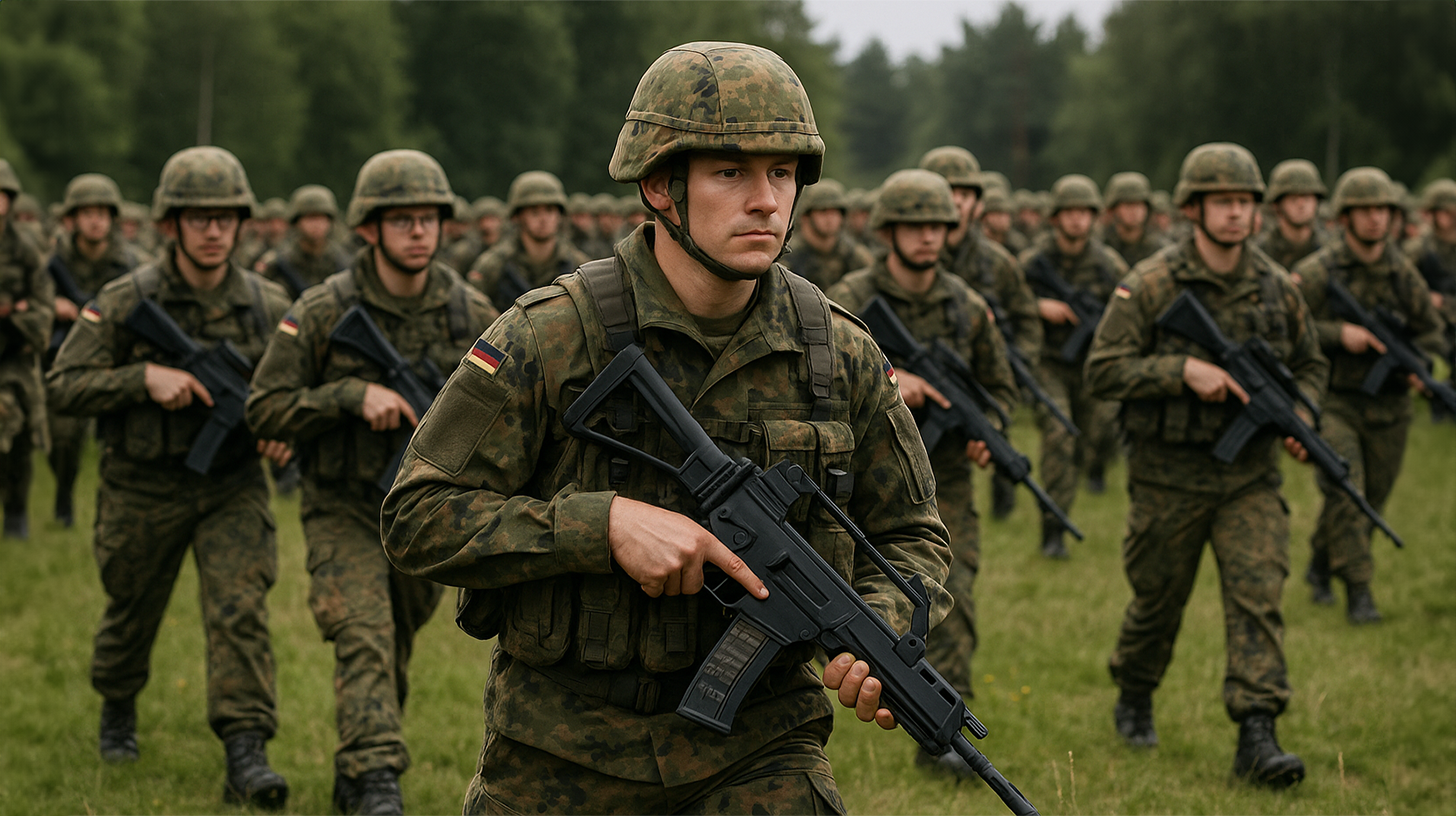
Bundeswehr expansion with 10,000 soldiers +1,000 more: Germany's path to the strongest army in Europe-Image: Xpert.digital
Bundeswehr structure: 10,000 soldiers and 1,000 civilians come in 2025
German defense policy before change through planned personnel offensive 2025
German security and defense policy faces a historical turn. With the massive personnel structure at the Bundeswehr planned for 2025, Defense Minister Boris Pistorius set a clear signal for the turn of the time in German defense policy. The 65-year-old SPD politician, who has headed the defense department since January 2023, may create 10,000 new soldier positions and an additional 1,000 civilian employees according to the current budget.
Suitable for:
- Artificial intelligence in the military: the Ki project “Uranos KI” of the Bundeswehr and its ethical implications
The current personnel situation of the Bundeswehr
The Bundeswehr is currently in a paradoxical situation: While the security policy challenges due to the Russian attack war on Ukraine have risen dramatically, the German army has been fighting with considerable personnel problems for years. At the end of March 2025, around 182,064 soldiers served in the German armed forces, with which the troop is significantly below the target strength of 203,000.
The Bundeswehr staff structure shows a worrying development: between 2019 and 2024, the average age of the Bundeswehr members rose from 32 to 34 years. The situation among managers is particularly critical - such as a fifth of the positions in non -commissioned officers and officers is vacant. In the team dormitory, the location with 28 percent vacant positions is even more dramatic.
Despite intensive recruitment campaigns and a task force staff who were deployed in 2023, the downward trend in the military staff could only be stopped, but was not yet reversed. After all, in 2024 the Bundeswehr recorded the highest -hiring year in five years with around 20,300 settings - an increase of around 1,500 soldiers compared to the previous year.
NATO requirements and the new threat situation
The planned personnel increase is not an arbitrary political decision, but a direct reaction to the changed security policy situation in Europe. Russia's violation war against Ukraine has shaken the European Peace Ordinance and once again focused on state and alliance defense as the core task of the armed forces.
NATO plans a drastic increase in its military skills to deter and defend it. The previously applicable targets for military skills are to be increased by around 30 percent, with a special priority on air and rocket defense, far-reaching weapon systems, logistics and large associations of land forces.
For Germany, this means specifically that the around 182,000 soldiers currently have to grow by a high five -digit number. Military experts assume that between 370,000 and 460,000 soldiers in the Bundeswehr would be necessary for effective alliance defense within NATO. This explains why the upcoming NATO summit will be discussed on around 260,000 men and women in uniform.
Challenges in personnel recruitment
The ambitious plan for recruiting people faces significant practical challenges. The Bundeswehr already needs around 20,000 new hires annually to compensate for the natural departures. The additional 10,000 jobs for 2025 mean a further increase of this already difficult to achieve.
The reasons for the recruitment problems are complex and reflect social changes. The generation of the 18- to 25-year-olds, the primary target group for military careers today, shows significantly less interest in a military career than previous generations. Instead of military service and military comradeship, start-ups, flexible working hours and home office opportunities in the private sector attract.
Added to this is the demographic change: the birth vintages become smaller, while at the same time the competition for qualified workers increases in a booming economy. Particularly educational applicants who are to serve technically demanding systems later are difficult to win because the private sector often offers them more attractive conditions.
Pistorius' reform plans and the Swedish model
In order to remedy the lack of personnel, Defense Minister Pistorius relies on a fundamental reform of the German military service based on Swedish model. The Swedish model, which has been practiced since 2017, is based on a balanced mix of voluntariness and selective obligation.
In Sweden, all 18-year-old men and women have to fill out an extensive questionnaire that enables comprehensive military recording. The Swedish army then specifically addresses the people suitable for them whether they want to do basic military service. Of a vintage of around 110,000 young people, only about 8,000 are moved in - significantly less than theoretically possible.
The Swedish system has proven itself: Most recruits report voluntarily, only if there are not enough volunteers can young people also be obliged to serve. Pistorius plans to introduce a similar system in Germany, whereby initially it is to be used for pure voluntariness. If this is not sufficient, it could be decided later on compulsory elements.
Suitable for:
- Sweden's historical upgrade: a turning point in European security policy - financing through borrowing
The importance of the reserve and long -term personnel planning
A decisive aspect of the Swedish model is the systematic integration of former military service providers in the reserve structure. After military service, young people remain fundamentally ordered for at least eight years and have to do at least two mandatory military exercises. This enables Sweden to use 116,000 soldiers in the event of war, although only 18,000 full -time soldiers are in the active service.
The establishment of a powerful reserve is also of central importance for Germany. The Bundeswehr currently has around 34,000 active reservists. Pistorius emphasizes that not only the standing forces have to be strengthened, but also plays an important role.
Financial framework and budget planning
The planned personnel structure requires considerable financial resources. The defense budget for 2025 is set to 53.25 billion euros, which corresponds to an increase of 2.5 percent compared to 2024. In addition, around 22 billion euros are available from the Bundeswehr special wealth for 2025.
The new coalition of the CDU/CSU and SPD has already announced that it will massively increase defense spending. An increase is discussed to up to five percent of gross domestic product, which would mean around 225 billion euros per year. This would be a tripling of current expenses and would make Germany the leading military power in Europe.
Infrastructure and equipment problems
In addition to the lack of personnel, the Bundeswehr is fighting with considerable infrastructure and equipment problems, which also make it difficult to build up the planned personnel structure. According to the military officer Eva Högl, there are many barracks in a disastrous condition, and ammunition, spare parts and functioning large device are lacking.
The valued need for renovation for the infrastructure amounts to around 67 billion euros. This means that parallel to the staff structure, massive investments in the structural infrastructure are necessary in order to be able to accommodate and train the additional soldiers at all.
The situation in equipment is particularly problematic. Although Germany has released materials worth around one billion euros to Ukraine since the beginning of the Ukraine War, only re-orders worth almost 50 million euros have been made. This exacerbates the Bundeswehr's already tense material position.
Suitable for:
- Criticism of the Bundeswehr: Plainless logistics investments-how the private sector can solve the logistics problem with the DU logistics²
Social acceptance and demographic challenges
The success of the planned personnel structure depends not only on financial resources and organizational reforms, but also on the social acceptance of the military turn. After decades of the peace dividend, German society has to deal with the reality of military threats again.
The challenge is tightened by demographic change. The age groups relevant to military service will become smaller in the coming years, while the competition for qualified workers is increasing. The Bundeswehr must therefore not only increase its attractiveness as an employer, but also develop innovative recruitment strategies.
Technological modernization and cyber defense
Personnel build -up must go hand in hand with the technological modernization of the Bundeswehr. In particular, the area of cyber and information space, in which around 13,800 soldiers currently serve, will have to be expanded. Modern warfare not only requires conventional armed forces, but also highly qualified specialists for digital defense.
The Bundeswehr must be able to deal with the latest technology and to develop it. This not only requires appropriately trained staff, but also close cooperation with the security and defense industry. The new security and defense industrial strategy provides to improve the framework conditions for companies and to promote key technologies in Germany.
International cooperation and European integration
German defense policy cannot be viewed in isolation, but must be seen in the context of the European and transatlantic security architecture. The new coalition emphasizes the importance of NATO membership and the need to make a central contribution to the Allianz's deterrent and defense ability.
At the same time, the European dimension of defense policy is strengthened. The EU member states are increasingly realizing that they have to take more responsibility for their own security. This not only requires national efforts, but also increased European cooperation in the armaments industry and the development of common defense skills.
From 10,000 to 60,000: Germany's ambitious plans for the Bundeswehr expansion
The planned personnel structure of the Bundeswehr by 10,000 soldiers and 1,000 civilian employees in 2025 is only the first step of a comprehensive realignment of German defense policy. The long -term goals are even more ambitious: Pistorius speaks of up to 60,000 additional soldiers who will be needed in the coming years.
The implementation of these plans will take years and requires a fundamental change in politics and society. The Bundeswehr not only has to grow in terms of personnel, but also increase its attractiveness as an employer, modernize its infrastructure and bring their technological equipment up to date.
The success of the turnaround in defense policy will depend on whether it is successful to successfully master the various challenges - personnel recruitment, financing, technical modernization and social acceptance. The coming years will show whether Germany will be able to fulfill its role as a reliable partner in NATO and EU and at the same time to ensure your own security.
The decision for the massive personnel structure in the Bundeswehr marks a historical turning point in German post -war history. After decades of mining military skills, Germany returns to a realistic assessment of the security challenges. Whether this course will be successful depends not only on political decisions, but also on whether German society is willing to accept the associated costs and changes.
Suitable for:
Hub for security and defense - advice and information
The hub for security and defense offers well-founded advice and current information in order to effectively support companies and organizations in strengthening their role in European security and defense policy. In close connection to the SME Connect working group, he promotes small and medium -sized companies (SMEs) in particular that want to further expand their innovative strength and competitiveness in the field of defense. As a central point of contact, the hub creates a decisive bridge between SME and European defense strategy.
Suitable for:
Your dual -use logistics expert
The global economy is currently experiencing a fundamental change, a broken epoch that shakes the cornerstones of global logistics. The era of hyper-globalization, which was characterized by the unshakable striving for maximum efficiency and the “just-in-time” principle, gives way to a new reality. This is characterized by profound structural breaks, geopolitical shifts and progressive economic political fragmentation. The planning of international markets and supply chains, which was once assumed as a matter of course, dissolves and is replaced by a phase of growing uncertainty.
Suitable for:

